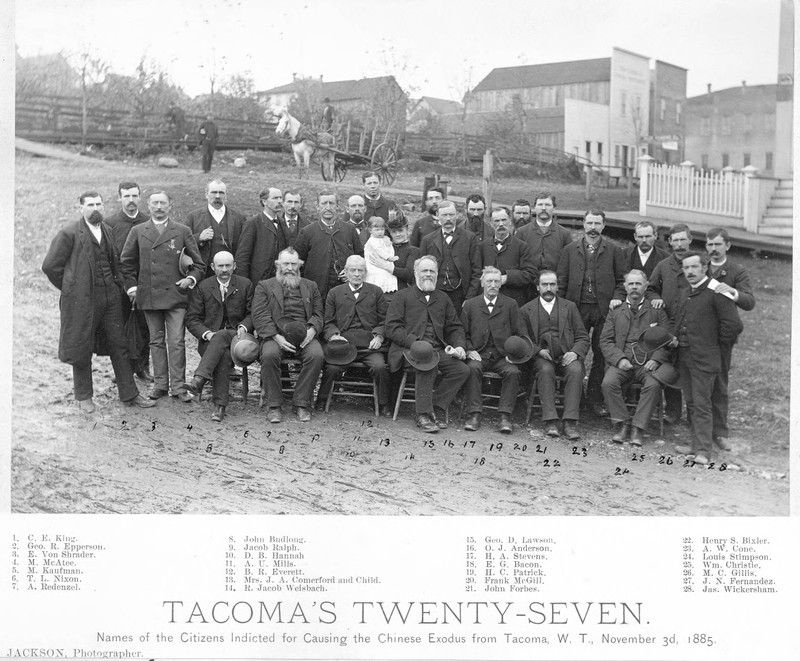Tacoma's Twenty-Seven
Introduction
Text-to-speech Audio
Images
Tacoma's Twenty-Seven, Indictees in the Chinese Expulsion

Backstory and Context
Text-to-speech Audio
Because of a slowdown in the economy and the large-scale cessation of railroad building, large numbers of Chinese workers were let go and migrated to the cities. While the Chinese had been brought to California beginning the late 1840s, mainly to help build the railroads, many Chinese also worked as servants and farm laborers. Many started businesses. By the mid 1880s, 500 or more Chinese lived in Tacoma.
Anti-Chinese sentiment was high all over the west. The contention was that Chinese were taking jobs away from whites by being willing to work for paltry wages. Anti-Chinese fever rose in Tacoma to a very high level in 1885. Tacoma's Mayor Weisbach was the leader of the conspiracy to drive the Chinese out of the city.
He had plenty of help from the Tacoma Daily Ledger, whose editor, Jack Comerford, supplied a steady stream of virulent articles. In January, after a brothel burned down, the property was leased for a Chinese laundry. The Ledger published a diatribe under the headline, “Chinese Invasion of Tacoma” and alarmingly asserted that allowing a Chinese laundry on Pacific Ave. would lead to a “contagion of their filthy numbers” that would rapidly result in the Chinese occupying the whole street.
Mayor Weisbach called meeting to deal with the “Chinese Problem.” On the night of September 7, several Chinese workers were killed in an ambush as the Chinese were driven from the hop fields at Issaquah. That same week, the Chinese workers were expelled from the coal mine at Coal Creek. Tacoma sent a large delegation, headed by Weisbach, to Seattle to participate in anti-Chinese rallies. On October 3, 500 anti-Chinese citizens paraded in Tacoma, and a “Committee of Fifteen” was organized to tell the Chinese that they must leave by November 1.
Many of Tacoma’s “Better Element” argued against expulsion, including George Atkinson, manager of the Tacoma Mill; Rev. W.D. McFarland, pastor of First Presbyterian Church; Gen. Sprague; Isaac Anderson; and Skookum Smith. From Puyallup, Ezra Meeker, pioneer settler and major hop grower, argued strenuously on behalf of the Chinese. To no avail. The Chamber of Commerce passed a resolution in favor of expulsion. On the morning of November 3, a whistle sounded at 9:30 a.m. and a large group of several hundred armed men began marching through the city telling the Chinese to pack up and get out of town.
Mayor Weisbach was a prominent member of the mob. So were the sheriff, a judge, and a member of the city council. By five in the afternoon, more than 100 Chinese had their goods put on wagons and were marched south out of town to the Northern Pacific station at Lake View. Seventy-seven tickets were sold for the morning train to Portland. Those who couldn’t afford a ticket rode in box cars. The Chinese shacks were burned.
Finally taking action, Gov. Squire asked that government troops be sent to Seattle to prevent the imminent forcible expulsion of Chinese from occurring there. Condemnation of Tacoma came from far and wide, including President Cleveland, the New York Times, the New York Herald, and the Portland Oregonian. Just a few days after the Chinese expulsion in Tacoma, a federal grand jury met in Vancouver, took testimony from witnesses (including Gen. Sprague, Rev. McFarland, and Ezra Meeker) and handed down indictments for conspiracy and insurrection against 27 men.
Those indicted included Tacoma Mayor Weisbach, two members of the city council, the fire chief, and a judge. Federal troops appeared in Tacoma on November 9 to make the arrests. The 27 were put on the train and taken to Vancouver, WA. Known as “Tacoma’s Twenty-Seven,” the 27 men are pictured and named in this group photo. Mayor Weisbach is seated in the middle of the front row. No one was ever prosecuted.
Cite This Entry
Tacoma Historical Society on behalf of Tacoma Historical Society. "Tacoma's Twenty-Seven." Clio: Your Guide to History. October 16, 2020. Accessed March 31, 2025. https://theclio.com/tour/1593/14
Sources
Hoard, Jim (curator). Building Tacoma (exhibit). Tacoma, WA. Tacoma Historical Society, 2013.
The 27, The Tacoma Method. Accessed October 16th 2020. https://www.tacomamethod.com/the27.
Hunt, Herbert. Tacoma: Its History and Its Builders; A Half Century of Activity. Chicago, IL. S. J. Clarke Publishing Company, 1916.
Morgan, Murray. Puget's Sound: A Narrative of Early Tacoma and the Southern Sound. Seattle, WA. University of Washington Press, 1979.
Reproduced from H.H. Hunt’s Tacoma, Its History and Its Builders: A Half Century of Activity

